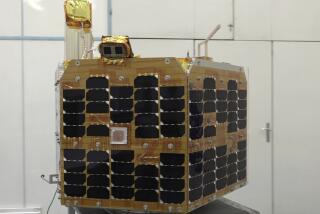India Successfully Launches Satellite-Carrying Booster Rocket
- Share via
NEW DELHI — India took a major step forward in space Saturday with the successful launch of its own four-stage booster rocket, meant to make the country one of the “big boys” in the business of commercial satellite launches.
Thirteen months after the first try ended in failure, Saturday’s blastoff was a white-knuckle triumph for India’s space scientists, who have had their share of flops and have had to work around a two-year U.S. ban on sales of space components to their nation.
But the launch is certain to revive concerns that the achievements of India’s space program will sooner or later be put to military use. Some media here have said the experimental booster could be used as an intercontinental ballistic missile, or ICBM.
The 145-foot-high prototype, designed to carry payloads of more than one ton, blasted skyward from Sriharikota Island off the eastern Indian coast at 10:30 a.m. local time.
Seventeen minutes later, the rocket put a 1,900-pound, Indian-made remote sensing satellite into a 500-mile-high orbit looping over the poles.
Scientists at the launch center in the southern state of Andhra Pradesh broke into stormy applause as the bulb-nosed rocket, officially designated the Polar Satellite Launch Vehicle, rose into a clear sky atop a pillar of flame.
The successful flight of the largest and most powerful booster ever built by Indians was a benchmark in the country’s drive to place its own satellites in orbit.
“The PSLV’s launch success is a step toward our quest for self-reliance,” President Shankar Dayal Sharma said in a message of congratulations to the Indian Space Research Organization.
“It’s a great, great day for us, a great day for ISRO, a great day for the country,” K. Kasturiraman, the space agency’s chairman, said.
The first attempt at launching the 283-ton PSLV failed Sept. 20, 1993, when the booster and satellite plummeted into the Bay of Bengal. That abortive 565-second flight was blamed on a software error in the on-board guidance system, and modifications were made.
Last year, Kasturiraman’s predecessor, U. R. Rao, predicted that the PSLV would put India “among the big boys in space.” Indian officials predict that the $135-million program will give them a commercial launcher competitive in technology and price with similar U.S., European, Russian and Chinese rockets.
India’s once-introverted and heavily regulated economy is now eagerly courting foreign capital and customers for its products, and the PSLV should be no exception. Indian officials estimate the country could earn $10 million to $15 million for each commercial launch of the PSLV.
India will not be shopping for business immediately, however. There must be at least two more successful flights before the PSLV is certified as operational, and the next flight is at least 12 to 15 months away.
More to Read
Sign up for Essential California
The most important California stories and recommendations in your inbox every morning.
You may occasionally receive promotional content from the Los Angeles Times.













